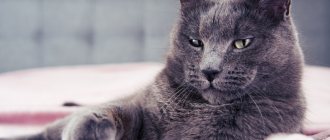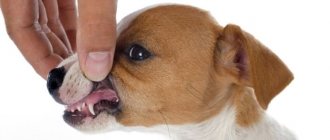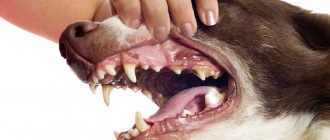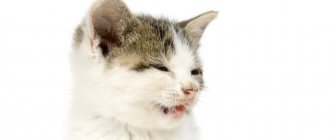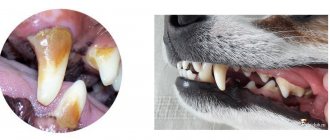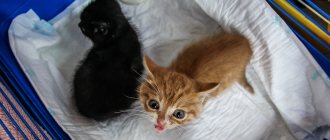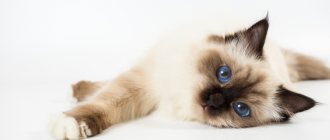3038Administration
From the lips of people who have never kept animals at home, the question sometimes arises: “Do cats have milk teeth or not?” Of course, experienced owners of furry beauties will be surprised at such ignorance. They “ate the dog at this”! But there is nothing wrong with such questions. Especially if they are asked by a person who has finally decided to get a pet. It is his responsibility to learn in advance how the cat’s body works and how the animal develops! So, let's put everything on the shelves.
Formation of the dentition
Kittens are born completely toothless, but already at 2-3 weeks of age they have their first milk teeth. Their eruption will continue for the next 3-6 weeks. Moreover, the process occurs in cats in a certain order according to age:
- 2-4 weeks – incisors;
- 3-4 weeks – fangs;
- 6-8 weeks – premolars.
Approximately by the age of two months, a “dental set” appears in the mouth, which includes 12 incisors (6 upper and lower), 4 canines (2 upper and lower) and 10 molars (6 lower and 4 upper). For some breeds, delayed eruption of incisors is considered normal.
A distinctive feature of cat teeth is that they do not recover when damaged and do not grow further after eruption. This is what causes the appearance at first of smaller milk teeth, corresponding to the size of the kitten’s jaw, which eventually fall out and are replaced by permanent ones. At first, the latter will look a little unusual from the outside: large teeth, like those of an adult cat, do not correspond to the parameters of an immature kitten. But as the animal grows, this “inconsistency” disappears.
This is interesting: How to determine how many kittens a cat will have?
Milk teeth in kittens
Kitten and its baby teeth.
Like most mammals, a cat first grows milk teeth, that is, temporary teeth. This process begins in three-week-old kittens and over the next 3–6 weeks all required 26 teeth grow in the following chronology:
- At 2-3 weeks of a kitten’s life, the first teeth appear - miniature incisors located in the front.
- At 3-4 weeks the fangs emerge.
- At 4–6 weeks, the small molars become visible.
Two-month-old kittens already boast a full set of teeth, consisting of 12 incisors (6 above, 6 below), 4 canines (2 above, 2 below) and 10 molars (6 above, 4 below).
The peculiarity of the structure of cat teeth is that they are not able to continue to grow or recover if damaged. This means that the kitten’s body continues to grow, but its baby teeth do not.
This is why kittens initially develop tiny “temporary” teeth that fully correspond to the small size of the jaw. But over time, as the kitten grows, there is a change to permanent teeth, which at first look a little strange: the kitten has not yet fully grown up, but already has large teeth, like an adult cat. Gradually this dissonance becomes invisible.
In addition, teeth contain minerals , in particular calcium, which is needed in large quantities so that the animal can chew solid food. During fetal development and the first months of a kitten’s life, a lot of calcium is spent on the development of bone tissue.
At what age do cats lose their baby teeth?
Milk teeth of a cat on the palm.
Mother Nature provided a compromise option in the form of baby teeth, when the kitten is not yet able to independently obtain and process “adult” food.
At the age of six months, growth in kittens becomes less intense, and then the time comes for full-fledged predator teeth.
How to tell if baby teeth are falling out
The kitten starts chewing everything!
It often happens that the change of baby teeth goes almost unnoticed by the owners. Nevertheless, there are a number of symptoms by which one can understand that this process has already started:
- increased salivation;
- minor bleeding from the gums;
- teeth become loose;
- appetite decreases slightly;
- increased desire to gnaw and bite whatever comes into the mouth.
Milk teeth are very sharp, resembling small, well-sharpened knives. The canines are curved and thin in the gum area. The permanent fangs are straighter and not so pointed; there is no thinning at the neck of the tooth.
There are often situations when, during the change of teeth, the kitten’s baby fangs do not have time to fall out, but new ones have already grown, that is, instead of the required four fangs, the baby has eight at once.
Sometimes it happens that the growing new tooth compresses the baby tooth, and the kitten begins to feel unwell: “cries”, loses appetite.
There is nothing wrong, you just need to remove the baby tooth, but doing it yourself is not recommended - you will need the help of a veterinarian and pain relief . At the same time, the specialist will check the condition of the bite and the reason why such a pathology occurred.
Peculiarities of cat behavior when changing teeth
A cat's mouth without milk teeth.
It happens that milk teeth may erupt with complications, causing a feeling of discomfort in the kitten.
It is not surprising that during this period the baby becomes more irritable and capricious . You just need to get over it, soon new teeth will grow, and your pet’s behavior will again become the same, cheerful and carefree.
The desire to chew something is quite normal and understandable when changing teeth. Everything that can be chewed is used: bed linen, toys, the owner's shoes. To prevent the kitten from ruining something valuable, there should be objects within its reach that you wouldn’t mind giving up to be torn to pieces. A kitten may bite your hands while playing, and it is important to wean him off these activities in time, otherwise they will turn into a bad habit.
The kitten may also have bad breath, which is also considered within normal limits. After a couple of months, when the situation with the teeth stabilizes, the smell will disappear.
Feeding during the period of loss of baby teeth
During the period when a cat’s baby teeth are falling out, it will benefit from phosphorus and calcium in its diet.
During this period, increased attention should be paid to feeding the pet. Additional supplements containing phosphorus and calcium . The food should not be too hard and tough so that the kitten does not damage its teeth while eating.
Video about how a cat lost its first baby tooth
General information
Normal growth rate of teeth in kittens
A person's teeth cut and grow often in a random order. In cats, the process is strictly distributed according to the purpose of each tooth. The incisors are the first to erupt at 15-20 days. They look completely unintelligible, but they are ideal for soft feeding for kittens.
By the way, kittens cut teeth much easier and with less discomfort than children.
Yes, drooling may appear, the kittens may scratch their faces, but the cats are deprived of heat and special pain in this process. At 3-8 weeks the fangs are cut. Such a large spread in time is associated with the characteristics of each breed and the size of the canine. These teeth are not small and take longer to emerge from start to finish than incisors.
At one month, kittens' molars erupt. In the milk version, these are barely noticeable small teeth. Kittens can easily do without them, but since an adult cat needs them, evolution has not abandoned their milk version.
Premolars are the last teeth to appear in kittens and their lifespan in the primary set of teeth is the shortest.
By 2.5-3 months, a healthy kitten should already have the entire set of 26 baby teeth.
Changing baby teeth in kittens
A kitten's milk teeth don't last very long. At 3.5 months, the process of changing them to indigenous ones begins. As a rule, the incisors are the first to go, followed by the canines, and then the molars and premolars mixed together. At this moment, it is important not to miss the fallen tooth and not to let it be swallowed. The root of a baby tooth can injure a kitten’s gastrointestinal tract. Therefore, if you notice a kitten’s milk tooth that is quite loose, gently remove it by shaking it.
IMPORTANT: changing baby teeth to molars can be accompanied by more discomfort in a cat than cutting through the first baby teeth. Carefully monitor the process and if your cat loses its appetite, becomes restless or has a painful reaction to touching its face, consult a doctor.
The complete replacement of milk teeth in cats and kittens with molars is most often completed by 6-7 months. At the same time, molars grow, which were not there in the milk version, and the incisors and molars become more expressive.
An adult cat should have a full set of thirty permanent teeth by the age of 10 months.
IMPORTANT: after the replacement of baby teeth with molars, cats begin the process of puberty. At 8 months, territory marking may already begin and by 9 months the first rut may begin. If you don’t want to miss out on time for the most painless spaying or castration, then keep an eye on your pet’s teeth changing. Between 7 and 8 months, the teeth should change and it is better to carry out the castration procedure immediately.
It would also be a good idea to temporarily switch the cat to a softer food during the change of baby teeth to permanent ones. Firstly, it will reduce the pain when the baby tooth is already loose and the molar is pressing on it from the inside. Secondly, with soft food there is less risk of missing a loose tooth, because you can pull it out during inspection, and the animal will not swallow it while trying to chew the food granules.
When feeding naturally, you need to adhere to the same principle. Do not let your cat chew a carrot or a cracker - this will only harm the young jaw and provoke the swallowing of a lost tooth.
IMPORTANT: when changing teeth, increase the amount of cottage cheese and fermented milk products in your diet. The kitten must receive enough calcium for the healthy formation of new teeth. You can also temporarily increase the number of servings of boiled sea fish, which will give the growing body additional phosphorus.
If the kitten itself begins to chew things and wires while changing teeth, then offer him special bones from pet stores. Their goal is to loosen the old tooth so that it falls out faster, but does not fall into the esophagus. After each bone, inspect your pet’s jaw for any loose teeth after a meal.
Peculiarities of teething in cats
As a rule, teething in kittens is painless; kittens may experience increased salivation, their gums become slightly swollen, the kitten tries to chew on various objects, and rubs its face with its paws. The moment when a tooth falls out can pass unnoticed - the kitten will eat the tooth along with food. When the baby teeth are replaced with molars, your pet's mouth may smell unpleasant - this is normal, the smell will disappear after a while.
During the period when a kitten’s teeth begin to grow, its body is weakened and susceptible to infections, so it is better not to vaccinate the animal at this time.
© shutterstock
What healthy cat teeth look like
This is what healthy teeth look like.
New, permanent teeth in a healthy animal should be clean and white. Over time, they acquire a yellowish tint, and dental plaque becomes noticeable.
Over time, cats' teeth wear down, fangs become dull, and some teeth may even be missing.
Older pets can easily manage without a few missing teeth. It is enough to feed them softer, crushed food.
ATTENTION, TEST! Answer a few simple questions and find out what kind of owner you are for your cat:
Does your cat have a name?
How often do you play with your pet?
Do you get your vaccinations and parasite treatment up to date?
Is your kitten spayed/neutered?
What do you feed your purr?
What kind of owner are you for your cat?
Your kitty is very happy
Congratulations! Your purr is healthy and happy, surrounded by care and love. You are a responsible and good owner for your kitty.
Your pussy could be happier
Hmm... with such an owner, even the cockroaches will all die. Maybe you should have gotten a cactus instead of a cat? Yes, you are not the best and most caring owner, but you still have a chance to fix everything. Start taking proper care of your pet.
During these several months, it is better not to vaccinate the purr, so that the vaccination does not harm its health.
Possible complications during the period of teeth change
Changing teeth is a natural process that can occur without problems for the animal. However, during the period of active growth of molars, you should inspect the animal’s mouth at least once every few days. It is important to consider that reddish and slightly inflamed gums are normal. However, in some cases complications arise. A caring owner should notice the problem in time and be sure to contact a veterinarian.
The most common complications that are visible to the naked eye:
- Suppuration of the wound at the site of the lost tooth.
- The animal shows anxiety, meows pitifully, and may experience severe lethargy.
- The kitten refuses to eat for two days.
- Very severe inflammation of the gums.
- Wounds appear from a missing milk tooth, in the place of which a permanent tooth has already grown.
- Some of the baby teeth have not fallen out, although the permanent ones have already grown in and the time for changing teeth has already passed.
In these cases, you should take the kitten to the clinic or call a doctor at home.
Don't hesitate to contact your veterinarian, even if your pet doesn't show signs of restlessness, lethargy, etc. A healthy animal also needs control, so veterinarians are very loyal to owners who bring healthy animals for examination and ask to monitor the process of changing teeth.
Gum inflammation
Inflammation of the gums is one of the most common complications during the period of teeth change. A little inflammation is normal, but in some cases it lingers and the gums become red.
Inflamed gums become swollen and red
Signs of gum inflammation:
- the animal is restless;
- refuses to eat due to painful sensations;
- tries to chew more;
- rubs its muzzle against everything in an attempt to relieve pain;
- profuse salivation occurs;
- swelling and intense redness are noticeable.
Of course, it is better to have a veterinarian do the diagnosis and treatment, but gum inflammation may go away when the kitten is switched to softer food.
Teeth change table
Most veterinary specialists are inclined to believe that there is no exact time frame for the appearance of baby teeth and their replacement with permanent ones. However, there are certain time limits, deviations from which should be considered as a developmental pathology.
Temporary deviations may be due to breed and genetic characteristics, nutritional and maintenance conditions. If the cat did not receive the necessary proteins, vitamins and minerals during pregnancy, the development of bones and teeth in kittens will be significantly delayed.
A healthy cat has a constant number of teeth until the end of its life. Loss of even 1 unit after the end of the shift is considered a pathology.
